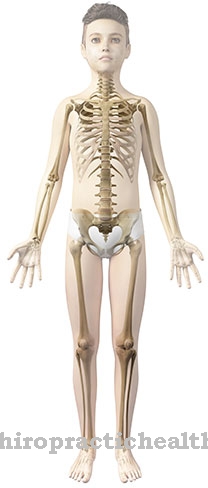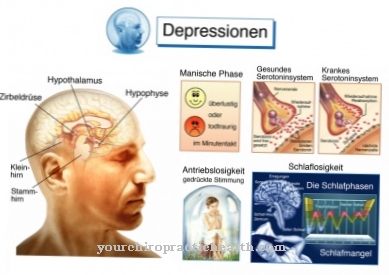The Hydronephrosis represents a pathological enlargement of the renal pelvis and the calyx system. It is also called Water sac kidney denotes and is caused by chronic urinary obstruction. In the long term, the increase in pressure in the renal cavity can lead to destruction of the kidney tissue.
What is hydronephrosis?

© nerthuz - stock.adobe.com
Hydronephrosis is a "sac-like" expansion (dilatation) of the urine collecting basin or renal cavity. The disease is the result of an obstruction of the urine flow with the resulting impairment or destruction of the kidney tissue. Hence it is also called Urinary stasis kidney or water sac kidney.
The problem lies in the inadequate drainage of urine, which leads to progressive expansion of the kidneys. Depending on the location, there is not only a sac-like expansion of the renal hollow system, but also the ureter. Hydronephrosis is therefore the result of excess urine pressure. Both kidneys are affected in only about 10% of cases. As the disease progresses, there is a significant reduction in kidney function.
If hydronephrosis becomes chronic, permanent damage to the renal parenchyma can occur, i.e. a loss of function of the kidney tissue. Reduced filter performance and, in the worst case, kidney failure can be the long-term consequences. Hydronephrosis does not necessarily have to be accompanied by symptoms immediately; possible first signs can be flank, back or abdominal pain, but also dizziness, vomiting or cramps.
causes
There are a variety of causes of urinary congestion. The classification of these occurs basically according to the localization of their occurrence; It is also crucial whether they are outside or inside the urine collecting basin. The most common reasons include mechanical constrictions, e.g. due to kidney stones in the urinary system.
This leads to a narrowing of the ureters and urine congestion. This flow obstruction leads, for example, to renal pelvic outlet stenosis. The group of mechanical causes of hydronephrosis also includes bladder cancer, bladder stones or a narrowing of the bladder neck. Causes localized outside the urinary system can be tumors that constrict the ureters and thereby impair the flow of urine, e.g. Prostate or uterine cancer.
Other triggers of hydronephrosis can be malformations that lead to urine flowing back into the kidneys: In this so-called vesicoureterorenal reflux, the ureter does not close (properly) after urination and reflux occurs.
More rarely, the urinary stasis kidney is also caused by neuromuscular diseases and the resulting urination disorders. This can happen with multiple sclerosis, quadriplegia or other neurogenic diseases (especially paralysis). In rare cases, drug abuse can also be causally related to hydronephrosis.
Typical symptoms & signs
- Flank pain
- Abdominal pain
- Back pain
- Muscle spasms
- dizziness
- Vomit
- Sweating
Diagnosis & course
Hydronephrosis does not have to lead directly to prominent symptoms. An acute urinary stasis kidney can cause symptoms similar to renal colic: severe, colic-like pain in the flanks, abdomen and back, possibly combined with cramps.
Blood in the urine is also a possible symptom in the acute course of the disease. The chronic development of hydronephrosis occurs rather slowly - here the symptoms can also be accompanied by pain, but also be similar to kidney failure: dizziness, nausea, vomiting, weakness, muscle spasms and local pressure, as well as disorders in the digestive tract are possible.
Ultrasonography of the abdomen, urinary tract and bladder is necessary as an imaging method. This also allows you to estimate the extent of hydronephrosis. Imaging procedures required to further clarify the cause are computed tomography of the abdomen as well as urethroscopy, as well as angiography and excretory urography.
Laboratory tests not only measure blood in the urine, the creatinine level is also crucial; he gives information i.a. about the filter performance of the kidney.If hydronephrosis remains undetected for a long time and the disease progresses, the long-term consequences are high blood pressure (hypertension) and kidney failure as well as permanent damage to the kidneys.
Complications
In the long term, hydronephrosis can severely and irreversibly damage the tissue on the kidneys. The person concerned primarily suffers from various pains, which, however, occur in the kidneys and back. In most cases, this pain spreads to other parts of the body.
The muscles cramp and epileptic fits can occur. The patients also complain of vomiting and dizziness. It is not uncommon for these symptoms to lead to a panic attack or sweating. Due to the constant pain, many patients are irritated and can no longer enjoy everyday life.
You withdraw from active life and the patient's resilience drops significantly. Digestive tract disorders can also occur. In the worst case, the affected person suffers kidney failure, so that he is dependent on a donor kidney or on dialysis. Without treatment, the patient will die from renal insufficiency.
The treatment does not lead to any further complications. However, its success depends heavily on the severity of the hydronephrosis and does not always lead to a positive course of the disease. Hydronephrosis can also reduce life expectancy.
When should you go to the doctor?
If symptoms such as abdominal pain or muscle cramps are noticed, you may have hydronephrosis. A doctor's visit is indicated if the signs of illness increase or have not subsided after three to four days at the latest. If there are additional symptoms, a doctor must be consulted. In particular, intense back pain as well as nausea and vomiting are clear warning signs that need to be investigated. If the kidney is actually congested, immediate treatment is necessary.
Patients who notice blood in their urine or have problems urinating should speak to their doctor. This is especially true if another illness is already present. Typical causes of hydronephrosis are kidney stones, bladder stones or bladder cancer. Malformations or neuromuscular diseases can also trigger hydronephrosis. If you have one of these conditions, you must see a doctor with unusual symptoms on the same day. The first examination can be carried out by the family doctor. A urologist or a nephrologist should then be called in, depending on the type and severity of the symptoms. If you have severe discomfort you should go to the hospital.
Doctors & therapists in your area
Treatment & Therapy
The treatment of hydronephrosis inevitably depends on the cause. The most important goal is, of course, to permanently restore the flow of urine from the kidney to the bladder and, in acute cases, to treat the patient's pain effectively.
In the case of a mechanical cause of the urinary stasis kidney, the removal of the flow obstacle comes first. This can be done through endoscopic or surgical removal. In any case, it is important to prevent infections in the urinary system. In the case of kidney stones as the cause of the water sac kidney, not only is pain therapy carried out, but measures are also used to remove the kidney stones from the urinary system.
If these cannot be eliminated naturally, the kidney stones in the urinary system are broken up by means of shock waves. If this is not possible, there are various alternative methods of renal pelvic surgery. Depending on the progress of the hydronephrosis, surgical relocation (recanalization) of the urinary tract can be carried out.
The attending physician has several options here: A stent (vascular prosthesis) can be implanted and a "new" ureter can be placed, similar to a bypass. Or he may choose to intraperitoneally the ureter, i.e. surgically relocate within the abdominal cavity. If these possibilities cannot be implemented, the creation of an artificial bladder outlet (urostomy) can be a therapeutic alternative.
The aim of all these measures is to restore the essential urine outflow and the excretion of urinary substances to a sufficient extent and to ensure this over the long term. If the mentioned therapeutic measures are no longer possible and the course of the disease or the damage to the kidney has progressed too far, a kidney removal may also be necessary.
Outlook & forecast
The prognosis of hydronephrosis depends on its cause and on rapid treatment. With successful therapy within a few days or weeks, the kidney tissue can completely recover. No kidney damage remains.
Without treatment, however, renal insufficiency can occur that is no longer fully curable. In very severe cases, there is even a risk of total loss of kidney function. Hydronephrosis is not that rare. Newborns and infants often develop them from congenital disorders. In pregnant women, it often occurs when the uterus exerts pressure on the urethra, and in men the so-called water sac kidney develops due to diseases of the prostate. Therefore, older men are usually affected in addition to pregnant women.
In contrast to men, the prognosis for hydronephrosis is generally very good for women. In almost all women, the kidneys return to normal after pregnancy without any treatment. Very often the disease is not even noticed at first because the kidneys expand only slowly. However, high blood pressure rarely develops as part of hydronephrosis. In some cases, the loss of urine production and, as already mentioned, damage to the kidneys is possible. Treatment for hydronephrosis depends on the cause. If the urinary flow disorder is eliminated quickly, there are usually no consequential damages to fear.
prevention
Since hydronephrosis has a very broad spectrum of possible causes, immediate prevention is very difficult. In any case, the general health of the kidneys and bladder can be influenced by ensuring an adequate supply of water - from childhood to old age.
The consumption of alcohol to a limited extent is to be regarded as just as beneficial in this context. A healthy lifestyle and drinking enough water are certainly the best preventive measures for this condition.
Aftercare
With hydronephrosis, the measures or the options for follow-up care are in most cases very limited or nonexistent. The person concerned is primarily dependent on early detection and treatment of the disease so that further complications can be prevented. This also prevents the symptoms from worsening.
In the worst case, however, hydronephrosis can completely destroy the kidneys, which can also lead to death of the person affected. The treatment itself is always based on the exact cause of this disease, so that no general prediction can be made. In some cases, medication can also be taken to alleviate the symptoms.
It is important to ensure that it is taken regularly and that the dosage is correct. If you have any questions or questions, you should first consult a doctor. If you have any questions about side effects or interactions with other drugs, you should always ask a doctor first. In some cases, hydronephrosis also makes psychological treatment useful. Contact with other people affected by the disease can also be useful, as this can lead to an exchange of information.
You can do that yourself
Hydronehphrosis requires immediate medical examination or care. If the causal kidney congestion is not very advanced, alternative means can be used to alleviate the symptoms and to resolve the congestion.
An effective household remedy is apple cider vinegar. Mixed with acacia honey and mineral water, it dissolves kidney stones and can prevent hydronephrosis. Homeopathy offers the remedy "Berberis vulgaris", which is used for various diseases of the excretory organs. Matricaria chamomilla or real chamomile also help with kidney pain. Urinary stones can be treated with Lycopodium. In addition, Schüssler salts can be used, especially sodium phosphoricum and lithium chloratum. The use of homeopathic remedies should first be discussed with a doctor.
If hydronephrosis has already formed, medical treatment is required. The patient can support the pain therapy or the treatment with shock waves by taking care of himself and not putting any further strain on the kidneys. The doctor in charge will answer exactly which measures are to be taken. In general, a healthy and balanced diet, adequate hydration, and light exercise are recommended, among other things.



























